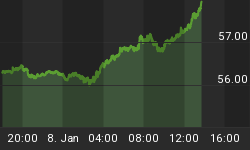This week, world attention finally shifted away from debt problems in Europe to the unresolved and worsening debt crisis here in the United States. The Congressional Super Committee, which had been created over the summer to postpone making tough cuts, chose to avoid responsibility itself. In so doing, the Committee has followed the path of least resistance and maximum irresponsibility. Given the likely after-effects, the outcome should be judged as criminal dereliction of duty. It should now be crystal clear to even the most casual observer that a solution to the U.S. debt crisis will not come from within, but will be imposed, perhaps brutally, from without.
But while the media focused on Washington, institutional investors remained focused on Paris and Brussels where beleaguered European banks continue to suffer from dangerous overexposure to bad sovereign debt. To avoid these risks, institutions are locked into a flight to what they perceive as 'safety.' Despite the abject failure of American politicians, many of these institutions may be flooding into U.S. dollars and U.S. Treasuries, driving yields to historic lows.
This unexpected fund flow is acting as a fortuitous camouflage for the U.S. Congress. With the U.S. dollar rising, and U.S. interest rates falling, the inability of Congress to curb its profligate spending habits appears in some eyes to be less urgent. At the same time, commonly held secure investments such as precious metals, appear to be increasingly volatile and viewed increasingly as less of a safe haven.
Both these conclusions are fatally flawed and risk serious investor disappointment.
First, it is likely that a collapse of either the euro or the European banking system will flow rapidly to America, threatening U.S. banks, the U.S. Treasury market and even the continued viability of the fiat dollar-based monetary system. In short, the U.S. dollar and U.S. Treasury bonds are two massive but latent bear traps. Investors should be wary of both.
Second, the safe haven aspects of precious metals, especially that of gold, have been distorted by the Fed. Most debtor central banks and politicians would be pleased by any reduction in the embarrassing 'safe haven' image of gold, and have historically done all that they could to undermine confidence in the gold market.
It is important to recognize the major distortion that Fed Chairman Bernanke has thrust into the gold price. Under his guidance, the Federal Reserve has abused its monopoly power to manipulate short-term interest rates, which are currently 1.5 percent below the level of inflation, a level that has inflicted, and will continue to inflict, untold damage on the economy. Negative real rates deny investors a secure economic repository for their cash. In reaction, many have used gold as an alternative to replace bank deposits. This added demand has boosted the marginal prices of gold and silver.
Today, precious metals appear to track stock markets. When stock markets rise, investors tend to hold their accumulated cash not in zero interest bank deposits, but in precious metals, driving prices upwards. When stocks fall in price, investors sell precious metals to raise cash to meet normal cash requirements including redemptions and margin calls, adding enormously to the marginal price volatility of precious metals. However, this volatility does not foreclose on gold's ability to retain its value when confronted with additional rounds of currency debasement.
Second, precious metals are not merely a hedge against inflation. They are insurance also against financial catastrophe. With quantitative easing likely to be the recommended panacea for recession, we may face economic recession accompanied by financial inflation and a threat to the fiat monetary system. If this disaster transpires, one major safe haven could be precious metals. As a result, Fed inspired short-term price volatility should not deter investors accumulating positions on price dips.
In short, the current news from both sides of the Atlantic should provide further reasons to feel comfortable with precious metals.
For an even more in depth look at the prospects of international currencies, download Peter Schiff's and Axel Merk's Five Favorite Currencies for the Next Five Years.
Subscribe to Euro Pacific's Weekly Digest: Receive all commentaries by John Browne, Peter Schiff, and other Euro Pacific commentators delivered to your inbox every Monday.
For a great primer on economics, be sure to pick up a copy of Peter Schiff's hit economic parable, How an Economy Grows and Why It Crashes.
















